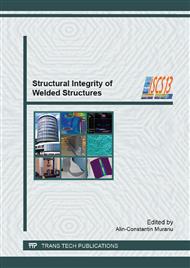[1]
M. Moravej, A. Purnama, M. Fiset, J.Couet, D. Mantovani, Electroformed pure iron as a new biomaterial for degradable stents: In vitro degradation and preliminary cell viability studies, Acta Biomater, 6 (2010) 1843-1851.
DOI: 10.1016/j.actbio.2010.01.008
Google Scholar
[2]
XN. Gu, YF. Zheng, Y.Cheng, SP. Zhong, TF. Xi, In vitro corrosion and biocompatibility of binary magnesium alloys Biomater., 30 (4), (2009) 484–498.
DOI: 10.1016/j.biomaterials.2008.10.021
Google Scholar
[3]
C. Lohan, B. Pricop, R.I. Comaneci, N.Cimpoesu, L.-G. Bujoreanu, Variation tendencies of tensile constrained recovery behaviour and associated structural changes during thermal cycling of a Fe-Mn-Si-Cr-Ni shape memory alloy, Optoelectron. and Advanced Mater.-Rapid Commun., 4 (2010) 816-820
Google Scholar
[4]
R. Waksman, R. Pakala, R. Baffour, R. Seabron, D. Hellinga, FO. Tio, Effect of pimecrolimus-eluting stent on intimal hyperplasia in porcine coronary arteries, Cardiovascular Revascularization Med., 8 (2007) 125.
DOI: 10.1016/j.carrev.2007.03.111
Google Scholar
[5]
H. Hermawan, A. Purnama, D. Dube, J. Couet, D. Mantovani, Fe–Mn alloys for metallic biodegradable stents: Degradation and cell viability studies, Acta Biomater, 6 (5), (2009) 1852–1860.
DOI: 10.1016/j.actbio.2009.11.025
Google Scholar
[6]
M. Schinhammer, AC. Hänzi, JF. Löffler, PJ. Uggowitzer, Design strategy for biodegradable Fe-based alloys for medical applications, Acta Biomater, 6 (2009) 1705–1713.
DOI: 10.1016/j.actbio.2009.07.039
Google Scholar
[7]
B. Pricop, U. Soyler, N.M. Lohan, B. Ozkal, D. Chicet, A. David, L. -G. Bujoreanu, Mechanical alloying effects on the thermal behaviour of a Fe-Mn-Si-Cr-Ni shape memory alloy under powder form, Optoelectron. and Advanced Mater.- Rapid Commun., 5 (2011) 555-561.
DOI: 10.1007/s12666-021-02215-8
Google Scholar
[8]
EL. Zhang, L. Yang, JW. Xu, HY.Chen, Microstructure, mechanical properties and bio-corrosion properties of Mg–Si(–Ca, Zn) alloy for biomedical application, Acta Biomater, 6 (2010) 1756–1762.
DOI: 10.1016/j.actbio.2009.11.024
Google Scholar
[9]
L.G. Bujoreanu, S. Stanciu, R.I. Comaneci, M. Meyer, V. Dia, C. Lohan, Factors Influencing the Reversion of Stress-induced Martensite to Austenite in a Fe-Mn-Si-Cr-Ni Shape Memory Alloy, J. of Mater. Eng. And Perform., 18 (2009) 500-505.
DOI: 10.1007/s11665-009-9499-2
Google Scholar
[10]
A. Charfi, T. Bouraoui, M. Feki, C. Bradai, B. Normand, Surface treatment and corrosion behaviour of Fe–32Mn–6Si shape memory alloy, B. CR Chim., 12 (2009) 270–275.
DOI: 10.1016/j.crci.2007.11.008
Google Scholar
[11]
. G.Z. Meng, C. Zhang, Y.F. Cheng, Effects of corrosion product deposit on the subsequent cathodic and anodic reactions of X-70 steel in near-neutral pH solution, Corros Sci, 50, (2008) 3116–3122.
DOI: 10.1016/j.corsci.2008.08.026
Google Scholar


